Nick Offerman's Blog, page 3
July 22, 2016
Notes from the 2016 Furniture Society Conference
By Lee:
Last month, I had the honor of presenting alongside Laura Zahn of Allied Woodshop and JD Sassaman of Pier 9 at the 2016 Furniture Society Conference in Philadelphia. The conference was packed with furniture makers, sculptors, academics and instructors, curators, and designers from across the US, Canada, and Asia. Presentations focused on the intersection of digital fabrication and craft in today’s furniture practice, but diverged into subjects as broad as psychoanalytic “objectology”, marketing for small businesses, and a drunken, rowdy group portfolio share dubbed “slide wars”. Our particular panel was about building community around craft and our three different models of collaborative or collective shops. Here are some of the excerpts (paraphrased) from our conversation, mediated by the talented Sarah Marriage.
Q: What is the ‘collective’ structure of your shop?
Laura: Allied Woodshop is a collective woodshop located in Downtown Los Angeles. We build community around furniture making by offering bench space, workshops, apprenticeships, and maker talks. Membership at Allied Woodshop gives woodworkers access to a full suite of woodworking machines and tools as well as a community of makers. We also offer workshops for beginner and advanced woodworkers with a focus on building confidence and skills in a fun and friendly environment.
JD: Pier 9 is a thriving creative community, with a cutting edge workshop hanging just over the Bay in San Francisco. Our Artist in Residence Program and Creative Partnerships bring architects, engineers, designers, makers, and thinkers from around the world to work side-by-side with the Instructables.com team and our Autodesk employees. The workshop is run by a small team of folks who are really committed to teaching people new skills, creating an empowering space for exploration, and supporting our shop users on their creative paths.
Lee: Offerman Woodshop was formerly structured as a group of independent woodworkers who all took on private commissions and built them out of the same shop. We paid the shop a 10% overhead fee on any of our commissions, which helped to cover rent, tool sharpening, and keeping the lights on. Recently, we have transitioned away from this model to a more conventional business structure, where our roles are more clearly stated and we work together on commissions for hourly wages under one cohesive OWS brand. Meanwhile, our online store still operates under a collective model—every member of the shop has a line of small goods we make and sell independently through the online store and 20% of our sales go back to the shop to pay for overhead. While our roles are more defined now, we still make most decisions about the store, and general shop operations together. We also eat lunch together everyday, and are lucky to enjoy each others’ company greatly.
Q: How does community/collaboration influence craft in your shop?
Laura: Community is a huge part of the environment at Allied Woodshop. The collective aspect of our shop allows us to problem solve and improve our work based on the input of the people with whom we share space. Many of the furniture makers who work at Allied Woodshop have recently moved to LA and are looking to meet people and build relationships in their new city. We provide a community that helps woodworkers to make connections and launch their careers.
JD: Pier 9 has an awesome collection of machines and equipment, but the spirit of the Pier community is what makes it special. We’ve built a culture of supported exploration, where shop users are encouraged to ask questions, try out new things, and get to know each other in the process. Our connection to craft is not traditional- it’s often more about thoughtfulness, exploration, learning from each other, and constantly evolving a process or a project with feedback from the community.
Lee: Because we work primarily on a one-off custom commission basis, every project we get is different from the last. This means we benefit greatly from the wide range of diverse skills and backgrounds in our small community of makers. Thomas and Nick can wield a chainsaw through a tree stump like nobody’s business, Josh likes exploring the nitty gritty chemistry of finishing, Krys’ attention to detail and perfectionism is key, Michele has mastered hand cut joinery, and Matty is a great educator. While the mythical craftsman toils away in solitude, at our shop every project engages us in some level of collective problem solving. Alone we may get stuck on a small detail for days, but with others around we bounce ideas off each other–finding better solutions faster. Finally, because we get along well and have plenty of fun working, I like to think our furniture pieces are imbued with an aura of both good craftsmanship and collective joy—the music, laughter and home cooked meals enjoyed in their making.
Q: How does craft influence the community?
Laura: Many of the furniture makers who find their way to Allied Woodshop have a traditional approach to furniture making – we value the skill involved in making things by hand. This approach shapes the conversations that happen in the shop, informs the types of tools that we purchase, and influences the work that we do. We also try to share these values with others by offering workshops that focus on traditional craft and hosting open houses to show and talk about our work.
JD: A lot of our work involves software, CNC machinery, and rapid prototyping machines like laser cutters and 3D printers. The idea of ‘craft’ in those spaces is really new. What we are learning at Pier 9 is that an approach to any of this work that includes patience, iteration, and attention to the results of your decisions ultimately leads to better and better work. These are major themes in any craft tradition. We are working in new mediums and with new materials, but a craft mindset still applies, and our users can study the marks of these digital tools and build rich understanding of the process and equipment and ultimately become masters of these new tools.
Lee: I have never had an office job, so its hard for me to talk from an unbiased perspective. That said, I believe that craft, and making high quality, useful things for a living, leads to a kind of satisfaction that is not always experienced in the typical day job. This creative satisfaction in turn leads to an empowered and fulfilled shop community and culture. The shared experience of craft and making (including the inherent financial and material struggles of craft as well as its many joys) also connects us to the larger community of makers in our local LA area. We share Friday beers, shop resources and techniques with our friends in the LA box collective, Monroe Workshop, WheelerMade, Allied Woodshop, Angel City Lumber and many more. The shared commitment to craft also binds us to the broader online community through social media, this very blog, and our newsletter—where we benefit from shared ideas, designs, and professional connections from around the world.
The post Notes from the 2016 Furniture Society Conference appeared first on Offerman Woodshop.
June 20, 2016
OWS at PS Arts benefit
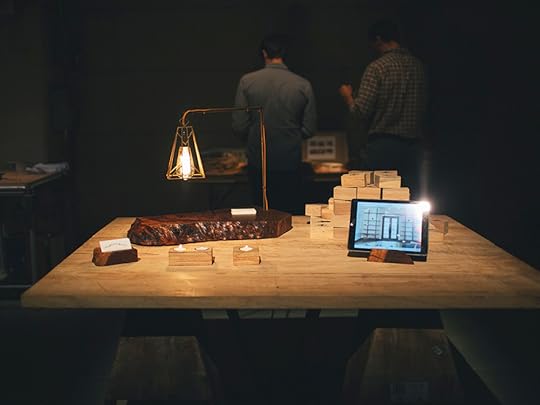
On May 20th OWS had the opportunity to give back to the community by participating in PS Arts 25th anniversary benefit. Typically a Friday evening for us at the shop entails burning scrap wood in our old Weber grill and sipping a well deserved adult beverage. Not that night. Lee and Matty, along with Jeff and Charles from Angel City Lumber, ventured to the big city lights of Hollywood.

The party was held at NeueHouse Hollywood (a fancy schmancy event space). The 4 of us blew the sawdust off our boots, combed our hair, and packed a few extra copies of our head shots. (Just kidding, Lee doesn’t have a head shot). PS Arts is a Los Angeles organization dedicated to improving the lives of children by providing arts education to underserved public schools and communities. The evening’s benefit was an opportunity to raise money through a silent auction and donations. The PS Arts team created a night of ‘imagination, innovation and play for adults’. That’s where we came in. We set up a station equipped with two bench top drill presses and ran a tea candle holder workshop.
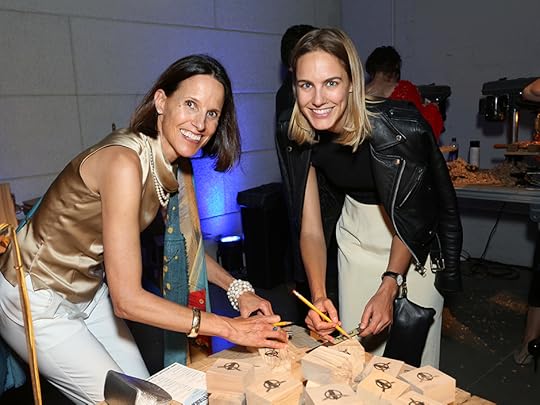
Guests picked out a block of salvaged local silver maple (milled by Angel City Lumber), marked their layout, drilled a shallow round pocket, hand sanded and waxed–all within a few minutes.

What appeared to be a very rudimentary exercise proved to be a lot of fun. Many of the adults attending had never had the opportunity to use a drill before.
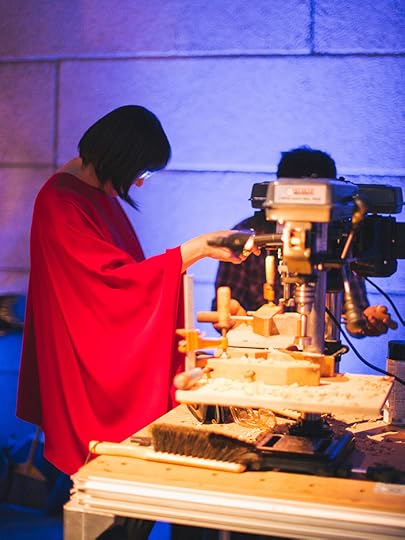
In a few short hours we cycled through almost 200 out of the 400 people attending. It was a huge hit! The key was finding a project that was quick, quiet, easy and safe enough for a party atmosphere.

PS Arts is a terrific organization and we were pleased to lend a hand to a good cause. Learn more about them on their website.

The post OWS at PS Arts benefit appeared first on Offerman Woodshop.
June 7, 2016
Summer Slabbing with Angel City Lumber
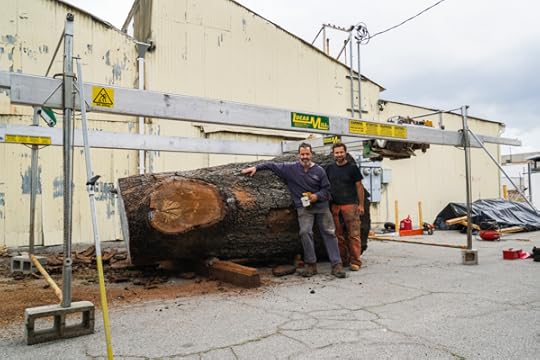
During the last two weeks of May, we joined with the brawn and brains of Angel City Lumber for our quadrennial slabbing session. These two urban foresters are the force behind a burgeoning sustainable lumber operation that collaborates with the municipality and private landowners to keep fallen trees from the landfill or the wood chipper and instead transform them into beautiful dimensional lumber, wood slabs, and millworks. In a fortnight, they, with some assistance from their 60” Lucas Mill slabber and forklift, sliced up and stacked around 25,000 lbs of green wood, most notably our monster Coastal Live Oak log.
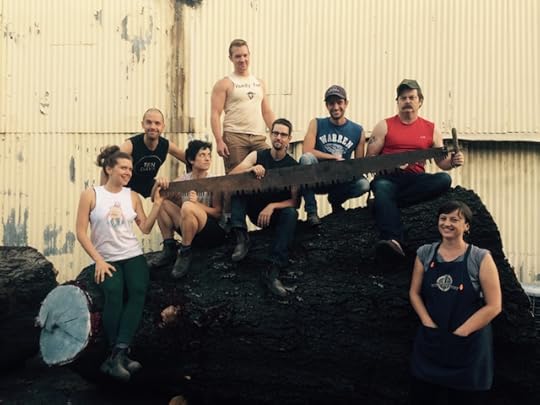
This beast, approximately the size of a Toyota 4Runner, had been parked beside our building since it was cut in Altadena last Spring, and we were delighted to finally take a look inside (and regain The Beef’s parking spot). Needless to say, the wood was veritable ham fudge, spalted as Stilton and full of beautiful figuring and color.

This, along with an Echo Park beech and some NoHo walnut, is now stickered and stacked deep in the bowels of our new slab storage annex, ready to spend several years basking in the uniquely desiccative Angeleno climate. While the Lumber Jocks made sawdust, Thomas (aka Tony) outfitted the space with some serious vertical integration in the form of two 12’ cantilever storage racks, enough storage for the majority of our cured slab collection.
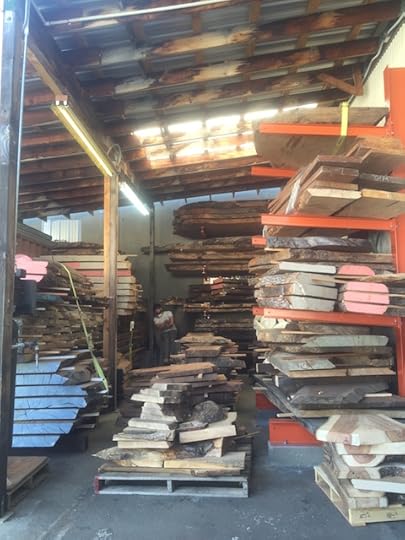
The team went to work and filled that space to capacity, breaking several sweats but thankfully nothing else of significance. With a cleared out back room, big changes are afoot for the OWS space, so stay posted for the remodel!
The post Summer Slabbing with Angel City Lumber appeared first on Offerman Woodshop.
May 19, 2016
Woodworkers’ trek turned into furniture for upcoming exhibition at Craft and Folk Art Museum

Last summer, two woodworkers and long time friends–Lee, shop manager at OWS, and J Sassaman, shop manager at AutoDesk’s Pier 9 workshop in San Francisco, shaved their heads and hit the southern Sierra for a 200 mile trek along the John Muir Trail.
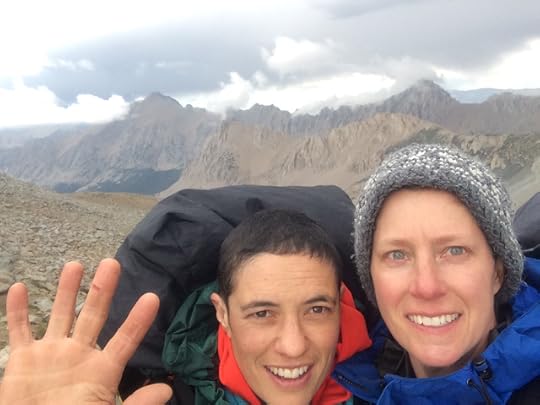
Along this historic trail and amidst this magnificent landscape, the two conceived of a collaborative project for the upcoming group exhibition “Windfall” at the Craft and Folk Art Museum in Los Angeles. The show features works from the LA Box Collective (of which Lee is a member), utilizing fallen trees from local storms that were salvaged into workable wood.
In conceiving of this piece, J and Lee were influenced by the strength and ubiquity of the granite landscape that surrounded them on their trek, and the unusually harsh weather which not only uprooted large trees around them, but also tossed tents and buried trails deep in snow. Their twenty-second and final night was spent at Red’s Meadow, the site of a particularly catastrophic windstorm known as the “Big Blowdown” which leveled thousands of old growth Red Fir and Lodgepole Pine trees in 2011.

It was also the site of Devil’s Postpile National Monument, a dark cliff of hexagonal columnar basalt formed by lava flow roughly 100,000 years ago.

Their piece for Windfall merges the temporal medium of wood with the seemingly eternal medium of stone exhibited at this particular trail junction. Execution of the project combined the traditional woodworking techniques employed at our low-tech Offerman Woodshop, with the cutting-edge digital fabrication technology used by the many artists at Pier 9.

The claro walnut slab came from a windfallen tree in Santa Rosa, CA that split in two during the drying process. JD and Lee will each keep one side of the slab table, with one half of the trail, and one half of the eight mountain passes they traversed in the Sierras.
Windfall by Box Collective opens May 29 and runs until Sept 4, 2016 at the Craft and Folk art Museum at5814 Wilshire Boulevard | Los Angeles, CA 90036
The post Woodworkers’ trek turned into furniture for upcoming exhibition at Craft and Folk Art Museum appeared first on Offerman Woodshop.
April 12, 2016
‘Good Clean Fun’ now on presale!

Hello Woodworking Enthusiasts and the actor Jim O’Heir!
So, the news is that we have a book coming out (my 3rd!) about Offerman Woodshop and woodworking in general. It promises to be a real gassy jam, with how-to chapters from every member of our collective including my Dad and my brother! There will also be assorted musings from yours truly on setting up a shop and wood in general, as well as some humor as always.
I personally dislike hearing about items for sale before they are actually available. It annoys me. I don’t want to see a trailer for The Desolation of Smaug in June when I can’t see the god-forsaken worm in a theater until December. You feel me? Nonetheless, the folks at my publishers don’t agree with me (large companies seldom do), and so we have had a “Cover Reveal” today via the charismatic folks over at Etsy. Since the cat is out of the bag, we figured you might as well get it here at the shop, right from the horse’s mouth.
Despite my irritation with the corporate overlords, I am terribly excited about this woodworking tome! Many of you have asked me to pen such a book, and I finally found time to be in the shop and pull it off, not to mention enjoy the camaraderie and fulsome assistance of all the collective (except my brother who has not exactly been “helpful” but he has been cute so we forgive him).
The book comes out, or “drops” October 17, but you can place an order now in case you have anxiety issues, like the folks at Penguin Random House apparently do. When you order one of my books from the shop, you get it signed by me, but at the cover price. I appreciate your interest and we want you to come back and order your dining room set from us, not to mention all of your live edge slab headboards. And a baseball bat.
Thank you kindly and please have a beautiful day.
Sincerely,
Nick Offerman
The post ‘Good Clean Fun’ now on presale! appeared first on Offerman Woodshop.
March 11, 2016
‘The Seer: A Portrait of Wendell Berry’ premiers at SXSW this weekend!

‘The Seer: A Portrait of Wendell Berry’ is premiering this weekend at SXSW. As an avid fan of the Kentucky farmer/writer, Nick has been very involved with the project. In Nick’s words:
“When I learned that Laura Dunn was making a Wendell Berry documentary, I immediately alarmed her with the enthusiasm of my enquiry. ‘Please let me do whatever I can to help your film! I will coil cable, I will sweep the barn, I will make sandwiches, I’ll wrangle livestock! I’m great with sheep! You name it!’ Laura placatingly said that she had those areas well-covered, but that I could possibly serve as a valuable cheerleader and fundraiser for the effort – so, after I calmed down, that is what I have proudly become.
As she was editing the picture, Laura happened upon a section in which Mr. Berry talks about artists making things, including a stool, and she thought it would be neat to have some footage of just such a stool being made, and, lucky for me, I just to happen to make things like stools in my woodshop. We brought in a gorgeous Arri Alexa camera and shot my hands and my tools and some California walnut with a great deal of personality as I fashioned it into a 3-legged stool with mostly vintage hand tools. My face never appears, and so I believe it is the finest film work I have done to date. I am sincerely humbled and honored to have the chance to support this beautiful poem of a film, espousing the world view of our most important American writer and thinker…and Seer, I reckon.”
They currently have a kickstarter campaign going so show your support! Plus there’s an option to get a handmade stool by the Offerman Woodshop.
The post ‘The Seer: A Portrait of Wendell Berry’ premiers at SXSW this weekend! appeared first on Offerman Woodshop.
February 26, 2016
OWS Reading List
By Lee:
We get a lot of emails from people wanting to get into woodworking and wondering where to start. While I always first point them in the direction of Off the Saw, where we teach woodworking workshops or College of the Redwoods, where some of us have sought refuge and instruction–the truth is that most of us have very little, if any formal training in woodworking. Almost all of what we know about woodworking we have learned on the job, from trial and error (a lot of error), from mentors and colleagues, and from reading BOOKS.
At OWS books guide us daily: from how-to books that refine our technical skills, to artist books which inspire our design and remind us to be patient and reverent in our practice, to scientific texts about the cellular structure of our medium, to more light hearted texts that remind us to have some fun with our work. So whether you are a soft-handed, starry-eyed novice, or a gnarled and jaded old woodchuck like me, here are some of our favorite books to guide you in your woodworking pursuits.
Keep in mind that we have a lot of overlapping favorites so if, for example, you are a die hard Josh fan (not only for his majestic and world famous facial hair, but also for his charm and ease in front of the camera), but its Nick who recommends “The Soul of a Tree”, rest assured–Josh most likely loves that book too.
Josh:
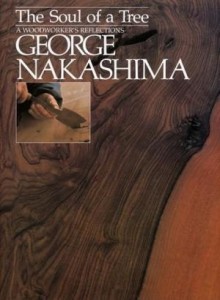 Inspiration:
Inspiration:
The Soul of the Tree by George Nakashima
This is a great book by one of our heroes about the process of milling, selecting, designing and building with slabs.
How-To:
Tage Frid Teaches Woodworking: Joinery by Tage Frid
This is a go-to text for any wood shop. The black and white photography is unfortunate, but Tage is so damn cute you wont care.
Laura (Off the Saw):
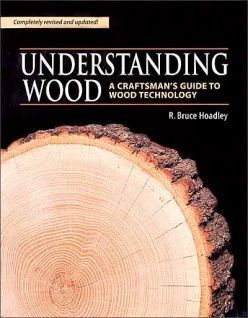 How-To:
How-To:
The Perfect Edge by Ron Hock
Keeping your tool sharps is fundamental to good building. Learn how to sharpen from the guy who makes and sells the best plane irons in the country.
The Complete Illustrated Guide to Joinery by Gary Rogowski
Understanding joinery is crucial for designing furniture that will last. This book will help you choose the right joint for the job.
Understanding Wood: A Craftsman’s Guide to Wood Technology by Bruce Hoadley
Want to geek out on the cellular level? This book is an informative guide to tree and wood science geared towards effective practices of working with this living medium.
Matty:
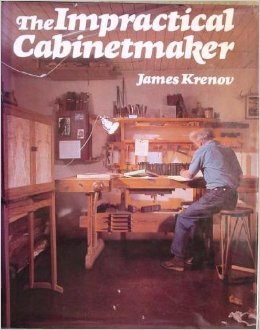 Inspiration:
Inspiration:
The Impractical Cabinetmaker: Krenov on Composing, Making and Detailing by James Krenov
Matty actually selected Harry Potter and the Goblet of Fire for this post, but I gave him this delightful Krenov book last year for Christmas so I’m deeming it his favorite book/best gift ever. Both practical and philosophical, Krenov’s Goblet of Grain wins every time.
Michele:
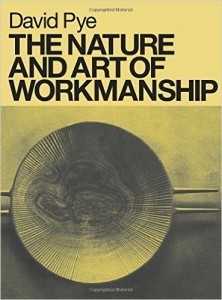 Inspiration:
Inspiration:
The Fine Art of Cabinetmaking by James Krenov
Some of us have had the luck to study in James Krenov’s program at the College of the Redwoods. This book is a good summary of the teachings there–including philosophical musings on practicing patience and letting the material guide the design, this book also delves into machine and hand tool techniques.
The Nature and Art of Workmanship by David Pye
Written in 1968, this text is still extremely relevant to craft today. Pye illustrates the vital importance of caring about one’s own craftmanship despite emerging technologies of automation and mass production (and today, digital fabrication). A fundamental read on design, theory and creative risk.
Nick:
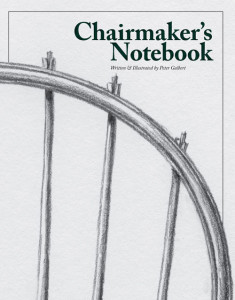 How To:
How To:
Canoecraft by Ted Moores
The official OWS go-to boat building book for all three of our shop made canoes.
Chairmaker’s Notebook by Peter Galbert
On how to work green wood with traditional hand tools, This book is guiding Nick through the completion of his first windsor chair and shaving horse.
Table saw Magic by Jim Tolpin & The Bandsaw Book by Lonnie Bird
Nick’s favorite jigs and tricks lie within these pages.
Jane:
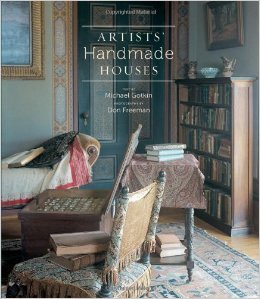 Inspiration:
Inspiration:
Artists’ Handmade Houses by Gotkin/Freeman
Peek inside the homes of our favorite craftsmen/designers such as Sam Maloof and George Nakashima.
Lee:
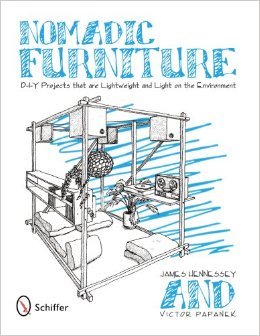 Inspiration:
Inspiration:
Nomadic Furniture by Victor Papanek and James Hennessey
A favorite for quick DIY projects–emphasizing the use of affordable, recycled, and generally accessible materials and tools. Plenty of 70’s hippy flavor: i.e. were they high when they wrote this book? Double check all of the dimensions–stoners are bad at math.
The art of Japanese Joinery by Kiyosi Seiki
Beautiful pictures of complex joints along with a succinct history of traditional Japanese construction and joinery.
The Craft Reader by Glenn Adamson
If you are interested in more theoretical pursuits–this book is a collection of excerpts which put our craft in the context of art history, mass production, capitalism, and technology.
Thomas:
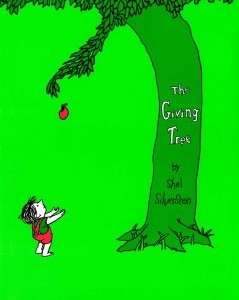 Mirthful yet Discouraging:
Mirthful yet Discouraging:
The Giving Tree by Shel Silverstein and The Lorax by Dr. Seuss
Great for the young and senior woodworkers alike! These books remind us to respect our trees and they make killer bedtime stories.
Changes in the Land: Indians, Colonists, and the Ecology of New England and Uncommon Ground: Toward Reinventing Nature both by William Cronon
This is the ecological and historical take on the problem posed by Shel Silverstein. Where does wood come from? The answer ain’t always pretty. With a forward written by my second cousin, colonial historian John Demos, how could you put this one down?!
The post OWS Reading List appeared first on Offerman Woodshop.
February 17, 2016
Off Cuts! episode 3
Off Cuts! Episode 3: Patching a Eucalyptus Slab
The post Off Cuts! episode 3 appeared first on Offerman Woodshop.
February 4, 2016
Taking a Seat in Boston
In December I had the immense pleasure of attending a 6-day Windsor chair workshop at Boston’s charismatic and venerated North Bennett Street School. Just touring the joint is like a trip to Disneyland, that is, if that particular playground of consumerism could teach one to build a violin or a high boy. My wife had a tour and a one-day class in book-binding, and now she’s hooked.
My own experience, in the capable hands of Peter Galbert (assisted by Tim Manney) was absolute woodworking nirvana. We started by learning how to rive green oak billets straight from the log, and then received a master class is tuning up and subsequently wielding a drawknife like an absolute Jedi on the shaving horse, shaving the oak lengths into spindles and bows to be steam-bent. Both Peter and Tim specialize in chairs and spoons, so their constant coaching of our fundamentals was poignant and gentle. By the way, one of the amazing attributes of working green wood with head tools is that 8 woodworkers were going fully at it, but we could have normal conversation at all times, with zero dust particulate in the air to boot. If you have not used a drawknife and a spokeshave with a shaving horse, I urge you to get at it. It’s a great education in wood science and the immense advantages of knowing where you grain fibers are helping/hindering the engineering of your chair or stool or what have you.
Peter continued to wow us with his techniques for carving the seat blank from Eastern White Pine, and I can attest that when I successfully hollowed out my seat’s fanny region with an inshave, thanks to his tutelage, I openly wept for joy.
He then gave us a quick coaching session in turning the Hard Maple legs, which he had prepared for us, as there was not time for all of us to learn that operation as well. Even his methodology for drilling and teaming the tapered tenons from the legs to the seat is astonishingly innovative.
If Peter’s chair class was of the quality of instruction one can expect from the North Bennett Street School, then by crikey I will be back for more. Until then, I am relying on his EXCELLENT book, A Chairmaker’s Notebook, to build my own shaving horse. We’ll check in on that project next time, but for now I’ll leave you with this photo, and Mr. Galbert’s criticism: “Looks nice…needs more spindles.”
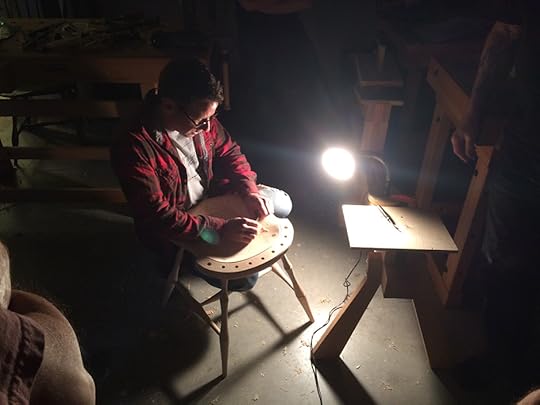 Peter Galbert himself demonstrating his use of a card scraper on a seat with a raking side light to emphasize the surface irregularities.
Peter Galbert himself demonstrating his use of a card scraper on a seat with a raking side light to emphasize the surface irregularities.

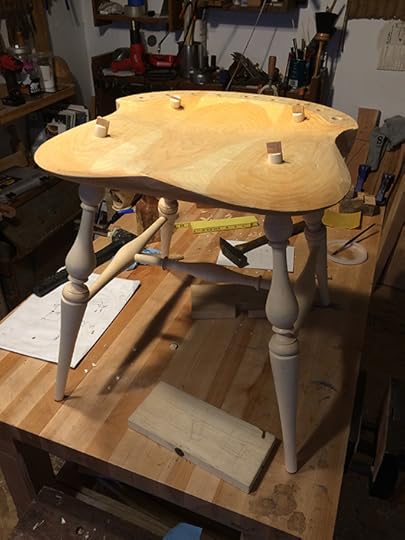

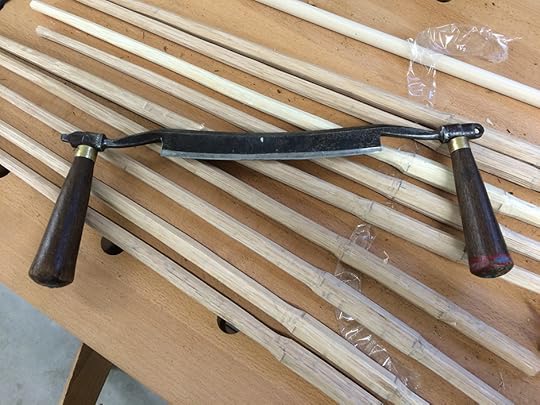
The post Taking a Seat in Boston appeared first on Offerman Woodshop.
January 9, 2016
Teaching with reclaimed timbers at Cal State University Long Beach
By RH Lee:
A couple years ago, a local woodworker/artist named Ryan Taber contacted Offerman Woodshop about a woodworking program at Cal State University Long Beach that he was in the process of bringing back to life. Shortly thereafter, Ryan came to the shop for an informal tour and soon we were all gathered around him in the break room, hot beverages flowing, listening to him describe a unique wood program and pedagogic vision that, had I been ten years younger, would have sent me running to the office of matriculation. As it happened, three of the Offerman Woodshop members sitting in that room that day–myself, Michele Diener, and Laura Zahn–have since joined the part-time faculty.
One of the most exciting aspects of the wood program at CSULB that Ryan spoke of that day, was the reclaimed urban timber component of
the curriculum. Established by Ryan’s predecessor Fred Rose, and run with the help of the campus arborist Brian McKinnon, this program saves ill or fallen trees in the campus forest from the usual fate of the woodchipper and landfill, allowing students and faculty of the Wood program to mill these trees into usable lumber for student projects. Since Ryan became director in 2013, he estimates that they have milled about twenty trees including Red Gum, Lemon scented gum, Iron Bark Eucalyptus, California Pepper, Chinese Elm, Black Locust, Oak, Ash, Indian Laurel Fig, Magnolia, Podocarpus, Red Wood, and Olive. This Fall, the students in my Introduction to Woodworking course got to both mill a freshly fallen tree into slabs and to build stools from air dried slabs of California pepper milled by students a couple years prior.

Students milling a Chinese Elm tree from the campus forrest with a Wood-Mizer, 2015
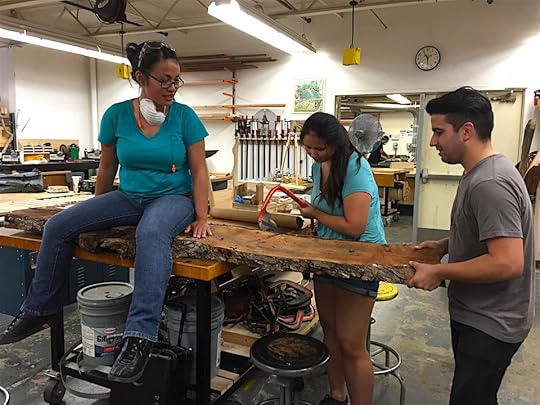
Students hand sawing California pepper slab, 2015
While traditional woodworking & joinery places a high premium on technical precision and pragmatic forethought, working with slabs forces students to be flexible and adaptive. Each slab has a unique set of challenges and defects that have to be navigated and problem-solved. Each slab also has its thrilling visual surprises hidden under the silvered rough-cut surface. My student Rachel Curray describes the revelatory process of sanding and oiling her slab: “I was blown away by how the colors of the grains came to life… It was gorgeous! The greens and purples that I admired so much when I
initially saw the milled pepper wood showed more vibrantly with every coat of oil”.
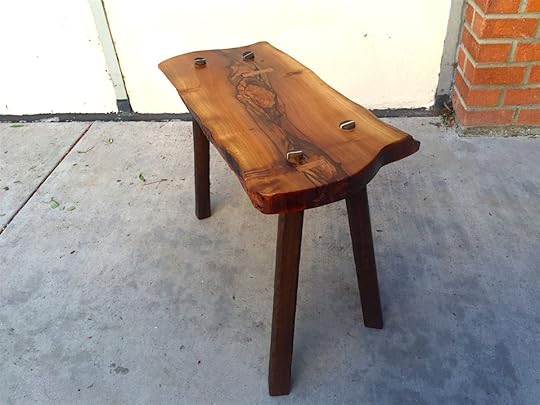
Finished stool–CA Pepper slab top, mahogany keys, hand-shaped stained poplar legs: Rachel Curray, 2015
The process of working with an organic slab is also much more sculptural and intuitive than working with dimensional lumber. Rather than concentrating exclusively on squaring up every piece of wood, students get to work with the natural, organic shape of the slab. Wood BFA Martin Hernandez says of building his slab stool, “Working in conjunction with the language of the wood grain and personality of the pepper tree slab, I took to my unconventional style of working and had a “conversation” with the wood…I used different methods of forming the slab between hand planers, electric planers, spoke shave, chisel, gouge, and angle grinder with various attachments using everything at my disposal to create a form that I was satisfied with.”

Finished stool–CA Pepper top, maple and mahogany butterfly keys, stained poplar legs: Martin Hernandez, 2015
Through this program, my students learned about sustainable building practices (when a tree becomes furniture rather than landfill, it retains carbon rather than releasing it into the environment). They also got to “have a conversation” with an organic living material–responding to the visual surprises of its surface, its organic shape, and its structural imperfections. The California State University system is struggling financially and it’s amazing what Ryan has been able to do with such a tight budget. Many thanks to Saburr-Tooth for donating the carving and shaping tools used on this project. The program is in need of new milling equipment including new chainsaws and a larger Wood-Mizer or Lucas Mill. For any other information or donations, please contact Ryan Taber at [email protected]
The post Teaching with reclaimed timbers at Cal State University Long Beach appeared first on Offerman Woodshop.
Nick Offerman's Blog
- Nick Offerman's profile
- 1837 followers



